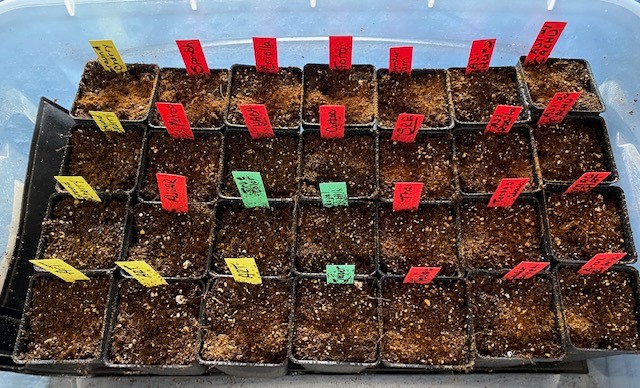What I Planted Today and Why
- Artichoke – Imperial – 3 plants. Artichoke is difficult to get to fruit here unless you take it inside over the winter. Considering the enormous size of the grown plant…I prefer to use artichoke as an interesting annual instead. I do plan the placement of the plant somewhere it can best return should mother nature deem that an option. I plant artichoke now as it can take some time to germinate, as well if it does decide to flower, it will need spell of cold weather. My plan is to harden and then put the plant outside in April, once temps overnight spend a few weeks in the 28-32 degree range.
- Peppers – multiple varieties – 16 plants. Pepper is a great plant to start early. Peppers overwinter in the house very easily. Unlike tomatoes, peppers in zone 5 do not succumb to blight or other diseases by the end of summer. Hence, a pepper plant here can be started early and will still be a healthy plant pumping out peppers until frost. Pepper plants are also smaller than tomato plants, so many types, a Thai pepper for instance, will take up less of that valuable last-weeks-indoors space. Another factor is the length of time some peppers can take to ripen. If I want a Sugar Rush Peach or a Thai pepper plant to have multiple fruits fully ripe before frost, I will need to start the plants inside early. My third consideration is the Aji varieties. Some Aji and other seasoning peppers (cachucha) can take over a month to germinate. If I want a healthy sized harvest, I need to have my peppers germinated by April 1st, at the latest.
Peppers started early-mid February. Round One.
-Ajvarski
-Melrose (super early, I will have ripe red peppers in June)
-Criolla
-Habanada
-Corbaci (early, I will have red ripe peppers in July)
-Poblano
-Thai/Birds Eye
-Monster Gum Peach
-Sugar Rush Peach
-Aji Rosita
-Aji Dulce #2
-Sweet Bonnet
-Tobago Seasoning
-Mad Hatter
-Cachucha
-Arroz con pollo - Tomatoes – 3 plants. Last year, I tried an experiment. I generally started tomatoes very early, in excitement to get those fresh homegrown maters in my mouth as soon as possible. Problem was, most plants were done for by late August, some before putting out a great number of fruit. My timing was off.
Even up north, tomatoes look worse for wear by the end of the season. The September tomato garden in Zone 5 is generally not a pretty one. Bugs, bacteria and viruses find the juicy tomatoes and plants targets for infection and infestation. Hail storms, winds and fall rains return. Last year, however, I did not plant tomato seeds inside until the first week of April, although it killed me to do so. My gamble yielded much fruit, literally. I had the best season of tomatoes ever. The plants were healthy until the end of September. They yielded a great deal of fruit. I got the timing correct.
So why am I starting three tomato seeds early? 1. The Jasper tomato is an early tomato that will give me tomatoes extra early while I wait for the rest. The Royal Hillbilly is also an earlier large red tomato I love, as is the third, Karen Olivier’s True Colors. 2. I plan to start a second round of a few tomatoes in June, so I have a few plants that hit their peak in September instead of August. The rest of the tomato plants will be started inside the first week of April and planted outside mid-may, weather dependent. I am only starting three tomato plants early for June and July harvest per the space I have available indoors. - Ground Cherries – 3. I love these. Garden crack. Growing early because I have to have them. I’ll see if they work in large pots and come back to let y’all know. Is Experiment.

I will detail my seed starting process in a Garden Chore post later this week. Check back if you like high germination rates.
The End
